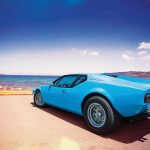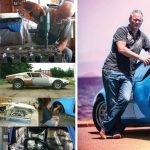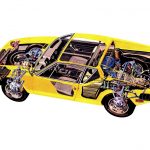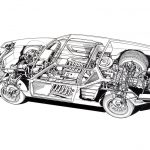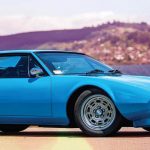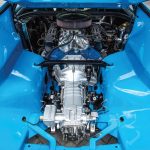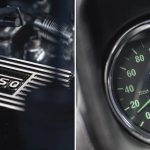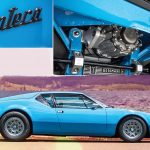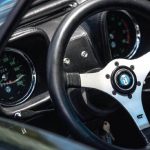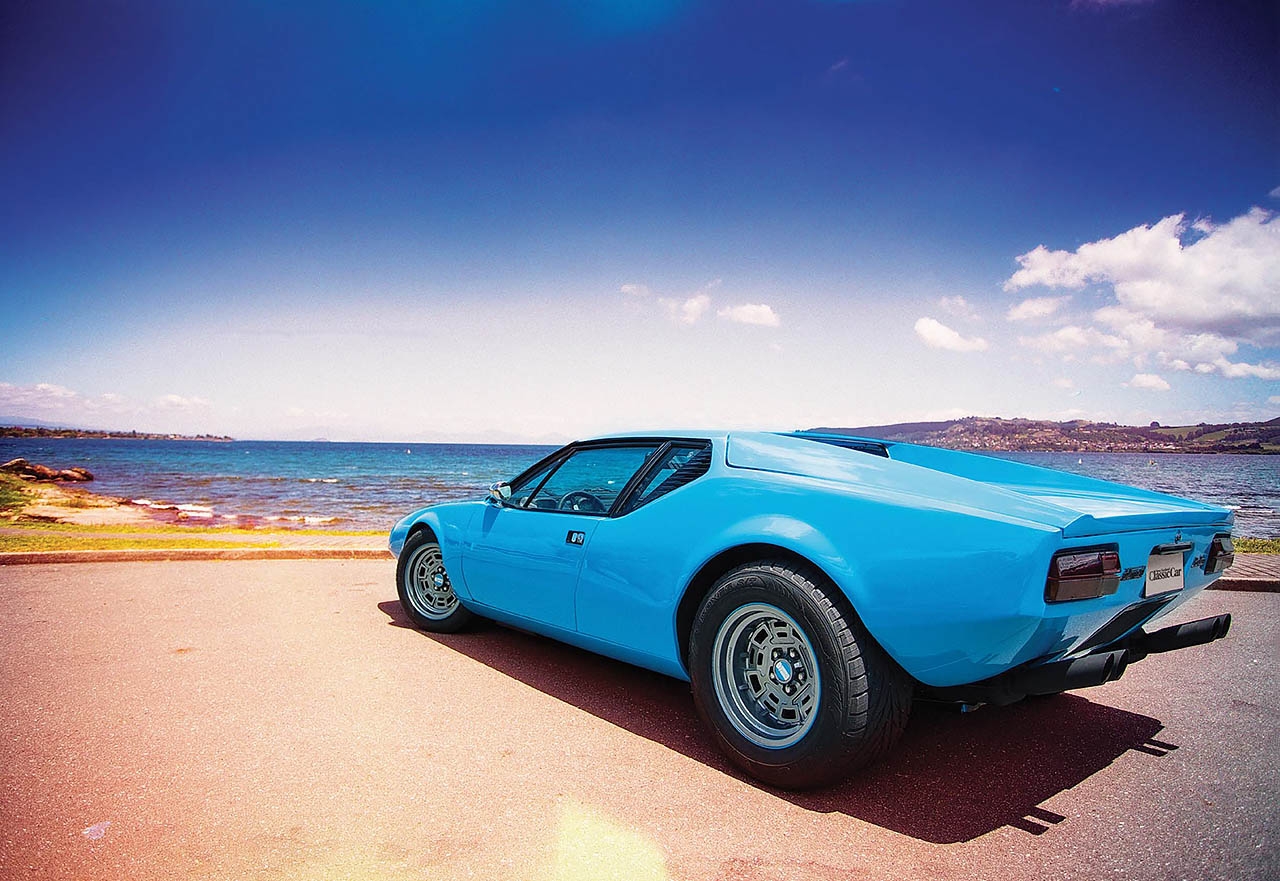
Blue Panther. With it’s striking Italian styling and midmounted Ford V8, De Tomaso’s Pantera offered supercar performance without the complexity of an Italian exotic. 1972 De Tomaso Pantera. Fancy Italian styling, reliable Ford V8 power and practicality, all allied to supercar performance — what’s not to like? Blue Panther. Words: Ashley Webb. Photos: Adam Croy.
Well, that’s another year gone and, by all accounts, with the economy following a slow-but-sure upward trend, the future looks a lot rosier for many of us than it did this time in 2013. As for the team at NZ Classic Car, it’s business as usual. We appreciate the ongoing support of our readers, and definitely look forward to featuring the very best selection of classic cars from all around the country for you to enjoy — and we’ve even got a few surprises up our sleeve for 2014.
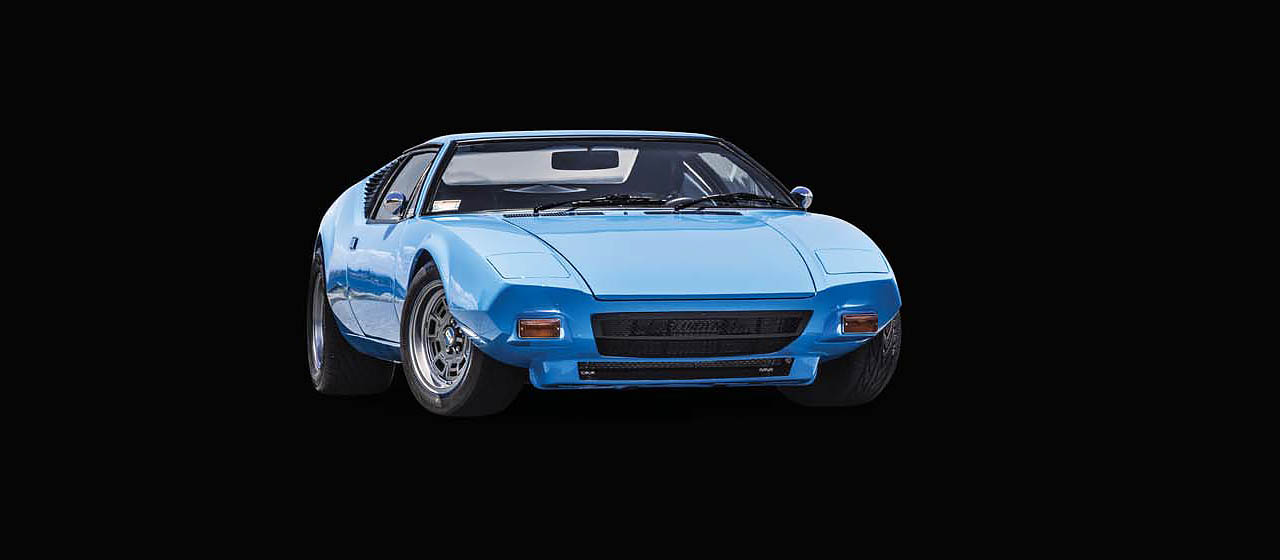
BIG CATS AND ASTONS
As February is generally New Zealand’s hottest time of the year, and with summer in full swing, we thought it appropriate to head down to the eastern shores of Lake Taupo where we caught up with Chris Wilson, the owner of this glorious De Tomaso Pantera.
Chris has owned his Pantera for many years, and he has only just completed a full restoration on the car. However, it’s not the first time he has attempted to restore this fine machine — his story is indeed an interesting one, to say the least, but before we delve into the intricacies of his De Tomaso project, let’s take a look back at his motoring past. Chris grew up on a farm in Central Hawke’s Bay, and from a young age learned to drive just about every type of farm contraption known to man. His father was a Ford man and changed his vehicles on a regular basis, owning everything from Falcon utes to Falcons to the more luxuriously appointed Fairmonts and Fairlanes.
Chris’ father also had a passion for Jaguars, owning two MkIIs and an S-Type, although his brother reckons their father had more tucked away. As an impressionable youngster, Chris gained a taste for nice, quality-built cars and remembers his father picking him up from school in a brand-new 1973 Ford Falcon XA GT. Six months later, the car was sold as Chris’ father felt the GT was far too big and powerful for his mother to drive, and he replaced it with an Aston Martin V8, one of the few in the country at the time — at least the Aston wasn’t as big as the Falcon GT!

If those Jaguars were enough to tantalize Chris in his early years, it was the Aston Martin that would prove to the ultimate catalyst for his lifelong passion for quality classic cars. Unfortunately, the Aston was sold the year Chris left school, so, apart from cleaning it regularly, he never got the opportunity to get behind the wheel and feel what it was like to drive one of these superb machines.
DATSUNS AND MGBS
Not exactly a British thoroughbred, Chris’ first car was a Datsun 140J, although that was soon replaced with a low-mileage Ford Escort MkII 1600 Sport and, by the time Chris was 18 years old, he’d developed a liking for MGBs, one being owned by a close friend.
After travelling and working his way through Europe and the US, Chris eventually settled in Australia where he purchased an MGB. Chris was working as a scuba instructor whilst living in Australia, and that’s where he met his wife, Kerry, before subsequently moving back to New Zealand a few years later. Chris knew he was cutting things fine when he gave himself only three days to sell the MG before departing Australia — probably in the hope that no one would respond to his advertisement in time, and he would have to bring it back to New Zealand with him. The cost to fly the car from Townsville to New Zealand in 1987 was NZ$1700 — insanely cheap compared with what it would cost nowadays, and that was definitely an option Chris was considering. However, he was surprised when someone fronted up almost immediately to test drive the MGB, and subsequently happily handed over the cash and drove off into the sunset. Although Chris was sad to see his beloved burgundy MGB head into the distance, he was chuffed by the fact that for the first time he’d actually made a profit — in this case $2000 — when selling a car. Upon returning to New Zealand in 1987, however, Chris invested this money in the share market and, sadly, lost the lot during the crash of ’87.
Chris and Kerry ended up farming in the Hawke’s Bay area, with Chris managing to pick up a later-model, rubber-bumper MG roadster for a reasonable price — a car he kept for about 12 months.
JAGUARS AND PANTHERS
During the mid 1990s, Chris decided that he was going to make his fortune by importing classic cars from the US, doing them up, and reselling them for a tidy profit.
Following some online research, Chris eventually discovered a Kiwi — Nick Clements from European Collectables in Southern California — who specialized mainly in Porsche 356s and E-Type Jaguars. Subsequently, he travelled to the US and spent some time with Nick (10 days to be exact), who kindly showed Chris several classic cars he might consider shipping back to New Zealand.
The first car Nick showed him was a metallic-green Ferrari Dino 246.
1972 De Tomaso Pantera FEATURE
At US$45,000, Chris decided to pass it up, but he now admits that a clever, more astute, classic-car buyer would have jumped at the opportunity given the prices these cars fetch on today’s market. What made it worse is that Chris reckons the only reason he didn’t buy the Dino was because he disliked the colour — a big mistake considering it was in otherwise mint condition and right-hand drive. Chris also looked at an Jaguar E-Type, which he slowly fell in love with despite the fact he would have preferred an XK140 or XK150, until he was talked out of it. At that time, Nick also had a car-finder-cum-spotter who alerted him to a De Tomaso Pantera. He thought this was definitely worth Chris looking at. As a result, both Chris and Nick headed out of Los Angeles to check out the Pantera — at this stage, it’s worth noting that Chris had never seen one of these US/Italian hybrids before.
On arrival at their destination, the first thing Chris noticed was a rear end — wide rear haunches and huge rear tyres exposed — poking out of a small garage. That immediately got him interested enough to want to see more. However, closer inspection revealed a somewhat dishevelled car with very evident signs of surface rust lurking under a grimy coat of white paint, which looked as if it had been applied by a child with a paint roller.
Let’s just say that the Pantera wasn’t looking its best, and even its alloy wheels hadn’t escaped the amateur paint job. Despite what Chris saw, he admits he virtually fell for the Pantera the moment he saw it. He’d never even heard of a De Tomaso Pantera, let alone seen one, but, according to Chris, the final clincher was when he lifted the huge rear hatch to discover a massive and original 351ci (5.8-litre) Cleveland V8 engine coupled to a ZF transaxle lurking in the cavenous rear engine bay. Chris knew he probably couldn’t afford the cost of maintaining a multi-valved Italian engine, but it was a different story when it came to considering a push-rod Ford V8. Long story short, Nick purchased the Pantera, loaded it onto his trailer, and hauled it back to his workshop. He also presented Chris with some enticing literature about the De Tomaso Pantera and a Classic Sports Cars of the World which, as you’d expect, just happened to contain a feature on a Pantera. The rest, as they say, is history.
BIG CATS
Chris initially imported three cars into New Zealand — an MGB, an E-Type Jaguar, and the De Tomaso Pantera. The MG cost a small fortune to convert to right-hand drive, took 10 years to sell, and lost Chris money, whilst he still owns the other two cars — proving that, in reality, his get-rich scheme was indeed flawed. Chris actually sold the MG to the local meter reader, who planned to invest some muchneeded love and attention into the car. The 1963 Series 1 3.8-litre E-Type was drivable but not able to be registered in New Zealand at that stage, until Chris had it converted to right-hand drive. That task was handled by Trevor Crowe in Christchurch, who had also converted the MG. Subsequently, the E-Type sat in the garage for a number of years whilst Chris decided to restore the Pantera.
By now it was 1995, and work on the Pantera essentially included a basic body and engine makeover, the task proving to be a huge learning exercise for Chris considering his limited knowledge of the marque.
The first step in the restoration process involved removing the engine, although, as Chris felt he lacked the confidence to completely strip the car, he chose to leave the suspension intact. He also removed all the parts of the interior that needed refurbishment. The next step was to strip away all the white paint to reveal a minimal amount of rust, which was easily repaired before the car was repainted. The new colour, describes Chris, was “hot tomatoey, reddy-orange”. The engine was freshened up and reinstalled and that was basically it, the Pantera having been done up just good enough to drive and enjoy.
FEDERAL PANTHERS
According to Chris, this Pantera is somewhat unusual given the fact it was built during the cross-over period — between the Pre-L and L models — when the US introduced new crash-impact regulations that saw the appearance of hideously large rubber bumpers mounted on the front and rear of many cars.
To properly gauge the model differences noted here, a little background information is in order.
As you most probably already know, the Pantera was born thanks to a collaboration between Ford and sports-car builder and former race driver Alejandro de Tomaso. From 1971 to 1974, the marriage produced an Italian-styled, hand-built, exotic sports car boasting a reliable and potent Ford V8 engine, the resulting car being about half the cost of a contemporary Ferrari or Maserati. In fact, the first Pantera, the aforementiond ‘Pre-L’ model, is considered the first affordable mid-engined exotic car. As it turned out — an oversight perhaps — the Pantera was designed with little or no regard whatsoever for impending US safety and emissions standards. As a result, in order to comply with the new Federal crash-safety regulations, an ungainly looking black rubber nose-guard and larger rear bumpers were bolted onto the 1973– model-year Pantera — these cars becoming known as the ‘L’ model. Engine power also fell drastically to meet 1973-1974 requirements. Ford was well aware the Pantera wouldn’t meet the even stricter Federal bumper standards planned for 1974, and that the revised standards would mean the Pantera would require a major redesign, including a new power train. At this point, Ford reckoned overall costs would make the Pantera — always, at best, a limited-volume car — unviable on the US market. As a result, importation of the Pantera into the US ceased after 1974, but it continued to be sold in other countries, including Australia and Europe, until production eventually ceased in 1991.
Along the way, like its contemporary the Lamborghini Countach, the Pantera acquired a whole plethora of add-on body parts. Taking the above into consideration, Chris refers to his unadorned De Tomaso as a ‘1972½’ model.
PANTHER SIGHTING IN TAUPO
In 2003, Chris and Kerry sold their farm in Hawke’s Bay, moved to Taupo, and treated themselves by having their E-Type fully restored by Beacham Jaguar. I have to say, the good doctor’s team has done a fabulous job on this car — so keep an eye out for it in a future issue. Chris then decided to make an attempt at disassembling the Pantera’s suspension with the intention of removing any unsightly overspray left over from the previous paint job, and, whilst he was at it, he also pulled the engine out once again to tidy up the engine bay. Then, in the latter part of 2005, Chris and Kerry purchased a business in Taupo, and that meant Chris had to re-prioritize his time, leaving none to work on the Pantera. The car then sat in Chris’ workshop, pretty much untouched, until 2010 when he met up with the owner of a very nice Ford Galaxy at Mount Maunganui. He told Chris all about Matamata Panelworks. Chris was impressed by what he heard, and decided to contact Malcolm Sankey at Matamata and arrange a time for him to view the Pantera in Taupo.
When Malcolm saw the Pantera, his advice to Chris was that it needed to be totally stripped to a bare shell and acid dipped, to fully assess the condition of the bodywork. Chris was aware the body sat 20mm lower at the right rear side — he thought it was a worn shock — so this would be an ideal time to check out the issue. They agreed to commence the project and, before Chris knew it, in 2011 the Pantera was undergoing a full-blown nut-and-bolt restoration.
As it turned out, the body wasn’t twisted; the car had been hit in the rear quarter and a new rear left quarter had been fitted to it. Unfortunately, it had been welded into place too high, giving the impression the body was slightly twisted. The team at Matamata Panelworks was able to remove the panel and weld it into the correct position. The body required some further minor rust repairs before it was etch primed and painted in striking Grabber Blue — this being the Pantera’s original colour, as discovered under the dash once the interior had been totally removed.
Whilst the engine and gearbox were out of the car, Chris took the opportunity to attend to the engine and transaxle. His research led him to a talented engineer, Don Catchpole, who at the time had just completed a very impressive GT40 replica, one of the best Chris has ever seen. Don agreed to inspect the ZF transaxle and, after completely stripping the unit, found it to be in good shape, requiring only gaskets and seals before reassembly.
The engine had been rebuilt sometime during the mid ’90s and Don offered to pull it apart and give it a thorough check. It turned out that the cylinder heads were out of square due to the fact they hadn’t been milled correctly. So, the heads were sent off to John at Matamata Automotive for this to be rectified.
Chris literally based himself in Matamata a few days a week on and off for 18 months, and became very hands-on during the entire restoration. Despite the fact he’d never pulled an engine apart, he worked on the Pantera’s engine under Don’s strict supervision and installed such items as forged pistons, the crank, and roller rockers.
Actually, Don performed all the major engine work whilst Chris pestered him with questions and was allowed to tighten a few bolts. Finishing touches included the installation of a 650cfm doublepumper Holley carburettor fitted to an Edelbrock Torker intake manifold, along with custom Hall big-bore exhaust headers. The engine was then completely balanced — around about 3kg was removed from the crankshaft and other moving components to ensure totally smooth running at peak revs. The original suspension received new bushes throughout and new QA1 adjustable shocks were fitted, replacing the original units.
The interior of the Pantera was in fairly good condition, and Chris chose to keep the original dash and centre console. The seats, formerly covered in vinyl, were reupholstered in black leather, and Chris found a set of fibreglass door panels which were also covered in black leather. The 15-inch Minilite-style wheels that came with the car were replaced with a set of original-style Campagnolo alloy wheels to complete the restoration.
Finally, in September 2013, the Pantera had its first shakedown run at Powercruise in Taupo.
Chris’ get-rich scheme may well have been a blessing in disguise — if you take a look into his home garage, you’ll see two totally contrasting classics restored to utter perfection. Indeed, a great story and two beautiful cars to be proud of.
TEN INTERESTING DE TOMASO FACTS
1. The De Tomaso Mangusta was designed to take Shelby’s Cobra head-on, hence the name, which is Italian for mongoose — the cobra’s only known enemy.
2. The Pantera was styled by Tom Tjaarda, his design being translated into metal by Vignale.
3. The Pantera made its US debut at the 1970 New York Motor Show.
4. In the US, Ford sold the Pantera through its Lincoln-Mercury dealership organization.
5. On inspecting the first Panteras to arrive in the US, Ford technicians discovered many design inadequacies and drew up a list of modifications — these included a complete front and rear suspension rebuild, the installation of around 60 strengthening gussets, air-conditioning alterations, reinforcement of the car’s steering-rack mountings, and further welding of the front and rear frame structures.
6. The Pantera went through many model changes during its long life — these include the GTS, GR3, GT4, GT5S, GR4, and GR5S. A Countach-like rear wing first appeared on the GT5 and subsequently became a popular retro-fit on earlier cars.
7. When Ford US finally pulled the plug on the Pantera, De Tomaso had to buy back 200 unsold and unfinished cars, all of which were subsequently sold on the European market.
8. The Pantera became a film star when a bright yellow example appeared in the 1976 movie Cannonball. Driven by a haughty and aristocratic German race driver (played by James Keach), the Pantera was easily the quickest car in the movie. Of course, both car and driver came to a sticky end.
9. Elvis Presley shot his Pantera on more than one occasion when it wouldn’t start. The King’s yellow car — a 1974 example — was purchased by him for US$2400 as a gift for his then girlfriend, Linda Thompson. This car is now on display at the Petersen Automotive Museum in Los Angeles.
10. Two years into its life, the Pantera was almost replaced with a Series II model. Designed by Ghia, the prototype was unveiled in 1974 but remained a one-off. Renamed the ‘Monttella’, the car remained on display at Ford’s Michigan headquarters until 1981 before being sold. The Monttella was auctioned in 2006, fetching US$99,000.
ACKNOWLEDGEMENTS
In his own words, Chris would like to thank all those involved with his Pantera project for their time, effort, skills, and patience:
• The entire crew at Matamata Panelworks. Malcolm Sankey for his generosity and patience — thanks for the memories and a lasting friendship. Nicky Sankey for her incredible hospitality. Richy for answering my dumb questions and helping put back all the stuff I couldn’t figure out where it came from, and to Dan for his never-ending tool supply. Johnny and June for their amazing panel skills.
• Matamata Paintworks — Greg and his team (Blair) for a fantastic paint job, and getting me to mask up before I started drilling and working on the car. Also for the touch-up pots and drift displays.
• Engine and transmission — Don Catchpole, what can I say? Thanks for your skill and time to build a great motor and transaxle, and your amazing patience in answering my never-ending list of questions — most of which I asked more than once — and showing me how to build a top-rate V8 from scratch.
• John at Matamata Automotive for dropping his tools and helping me out when I came knocking.
• Electrical — to Paul and his team at Onsite Auto Electrical, for work done, questions answered, countless returns, and borrowed tools.
• All questions related to De Tomaso Panteras — Paul Donderwinkel; thanks, mate.
• To Peter Holt for giving me a hand all those years ago to get the engine and transaxle out of the car. Peter probably gave up thinking it was ever going to be completed!
• Finally, thanks to Glen from Taupo Mechanical Services for helping me locate the pesky oil leak that showed up after the car had been completed.
| 1972 DE TOMASO PANTERA |
| ENGINEFord Cleveland 335-series V8 |
| CAPACITY5766cc |
| BORE/STROKE 101.6×88.9mm |
| VALVESTwo per cylinder |
| C/R 11:1 |
| MAX.POWER 231kW at 5400rpm |
| MAX.TORQUE 515Nm at 3400rpm |
| FUEL.SYSTEM Holley 650cfm carburettor as tested |
| TRANSMISSION Five-speed ZF |
| SUSPENSION F/R Unequal-length upper/lower A-arms with coilover shocks |
| STEERING Rack and pinion |
| BRAKES Power-assisted discs |
| DIMENSIONS: |
| OVERALL LENGTH 4242mm |
| WIDTH1702mm |
| HEIGHT 1102mm |
| WHEELBASE 2500mm |
| KERB WEIGHT 1297kg |
| PERFORMANCE: |
| MAX. SPEED 260kph |
| 0–100KPH 5.2 seconds |
| STANDING QUARTER–MILE 13.6 seconds |
| CLUB Drive-My De Tomaso Page |

